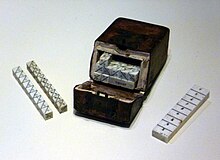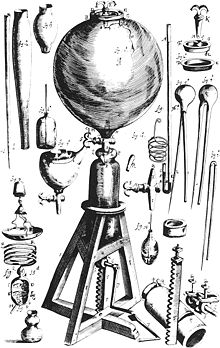User:Evanmayer1/sandbox
Adding info on the aesthetics of scientific instruments to this page: Scientific revolution. This could go in many places on Wikipedia, although the current setup of Scientific instrument and Instrumentation or even science pages don't really support its addition. The breadth of what I'm interested in covering doesn't all fit in the era described by the Scientific revolution page, so I will only include what is relevant to the time period, I guess. The rest will have to go on UChicago wikispaces. I think it's important because the materials, manufacturing techniques, and look of instruments have changed drastically over this time period, and what remains of instruments today colors our views of the science being done then.
Below is a paste of the page as it currently appears, which I will add edits to. My additions are "Materials, construction, and aesthetics" below "Other devices".
New mechanical devices[edit]
As an aid to scientific investigation, various tools, measuring aids and calculating devices were developed in this period.
Calculating devices[edit]

John Napier introduced logarithms as a powerful mathematical tool. With the help of the prominent mathematician Henry Briggs their logarithmic tables embodied a computational advance that made calculations by hand much quicker.[1] His Napier's bones used a set of numbered rods as a multiplication tool using the system of lattice multiplication. The way was opened to later scientific advances, particularly in astronomy and dynamics.
At Oxford University, Edmund Gunter built the first analog device to aid computation. The 'Gunter's scale' was a large plane scale, engraved with various scales, or lines. Natural lines, such as the line of chords, the line of sines and tangents are placed on one side of the scale and the corresponding artificial or logarithmic ones were on the other side. This calculating aid was a predecessor of the slide rule. It was William Oughtred (1575–1660) who first used two such scales sliding by one another to perform direct multiplication and division, and thus is credited as the inventor of the slide rule in 1622.
Blaise Pascal (1623–1662) invented the mechanical calculator in 1642.[2] The introduction of his Pascaline in 1645 launched the development of mechanical calculators first in Europe and then all over the world.[3][4] Gottfried Leibniz (1646–1716), building on Pascal's work, became one of the most prolific inventors in the field of mechanical calculators; he was the first to describe a pinwheel calculator, in 1685,[5] and invented the Leibniz wheel, used in the arithmometer, the first mass-produced mechanical calculator. He also refined the binary number system, foundation of virtually all modern computer architectures.[6]
John Hadley (1682–1744) was the inventor of the octant, the precursor to the sextant (invented by John Bird), which greatly improved the science of navigation.
Industrial machines[edit]

Denis Papin (1647–1712) was best known for his pioneering invention of the steam digester, the forerunner of the steam engine.[7] The first working steam engine was patented in 1698 by the inventor Thomas Savery, as a "...new invention for raising of water and occasioning motion to all sorts of mill work by the impellent force of fire, which will be of great use and advantage for drayning mines, serveing townes with water, and for the working of all sorts of mills where they have not the benefitt of water nor constant windes." [sic][8] The invention was demonstrated to the Royal Society on 14 June 1699 and the machine was described by Savery in his book The Miner's Friend; or, An Engine to Raise Water by Fire (1702),[9] in which he claimed that it could pump water out of mines. Thomas Newcomen (1664–1729) perfected the practical steam engine for pumping water, the Newcomen steam engine. Consequently, he can be regarded as a forefather of the Industrial Revolution.[10]
Abraham Darby I (1678–1717) was the first, and most famous, of three generations of the Darby family who played an important role in the Industrial Revolution. He developed a method of producing high-grade iron in a blast furnace fueled by coke rather than charcoal. This was a major step forward in the production of iron as a raw material for the Industrial Revolution.
Telescopes[edit]
Refracting telescopes first appeared in the Netherlands in 1608, apparently the product of spectacle makers experimenting with lenses (Inventor is unknown but Hans Lippershey applied for the first patent, followed by Jacob Metius of Alkmaar).[11] Galileo was one of the first scientists to use this new tool for his astronomical observations in 1609.[12]
The reflecting telescope was described by James Gregory in his book Optica Promota (1663). He argued that a mirror shaped like the part of a conic section, would correct the spherical aberration that flawed the accuracy of refracting telescopes. His design, the "Gregorian telescope", however, remained un-built.
In 1666, Isaac Newton argued that the faults of the refracting telescope were fundamental because the lens refracted light of different colors differently. He concluded that light could not be refracted through a lens without causing chromatic aberrations[13] From these experiments Newton concluded that no improvement could be made in the refracting telescope.[14] However, he was able to demonstrate that the angle of reflection remained the same for all colors, so he decided to build a reflecting telescope.[15] It was completed in 1668 and is the earliest known functional reflecting telescope.[16]
50 years later, John Hadley developed ways to make precision aspheric and parabolic objective mirrors for reflecting telescopes, building the first parabolic Newtonian telescope and a Gregorian telescope with accurately shaped mirrors.[17][18] These were successfully demonstrated to the Royal Society.[19]
Other devices[edit]

The invention of the vacuum pump paved the way for the experiments of Robert Boyle and Robert Hooke into the nature of vacuum and atmospheric pressure. The first such device was made by Otto von Guericke in 1654. It consisted of a piston and an air gun cylinder with flaps that could suck the air from any vessel that it was connected to. In 1657, he pumped the air out of two conjoined hemispheres and demonstrated that a team of sixteen horses were incapable of pulling it apart.[20] The air pump construction was greatly improved by Robert Hooke in 1658.[21]
Evangelista Torricelli (1607–1647) was best known for his invention of the mercury barometer. The motivation for the invention was to improve on the suction pumps that were used to raise water out of the mines. Torricelli constructed a sealed tube filled with mercury, set vertically into a basin of the same substance. The column of mercury fell downwards, leaving a Torricellian vacuum above.[22]
Materials, construction, and aesthetics[edit]
Surviving instruments from this period,[23][24][25][26] tend to be made of durable metals such as brass, gold, or steel, although examples such as telescopes[27] made of wood, pasteboard, or with leather components exist.[28] Those instruments that exist in collections today tend to be robust examples, made by skilled craftspeople for and at the expense of wealthy patrons.[29] These may have been commissioned as displays of wealth. In addition, the instruments preserved in collections may not have received heavy use in scientific work; instruments that had visibly received heavy use were typically destroyed, deemed unfit for display, or excluded from collections altogether.[30] It is also postulated that the scientific instruments preserved in many collections were chosen because they were more appealing to collectors, by virtue of being more ornate, more portable, or made with higher-grade materials.[31]
Intact air pumps are particularly rare.[32] The pump at right included a glass sphere to permit demonstrations inside the vacuum chamber, a common use. The base was wooden, and the cylindrical pump was brass.[33] Other vacuum chambers that survived were made of brass hemispheres.[34]
Instrument makers of the late seventeenth and early eighteenth century were commissioned by organizations seeking help with navigation, surveying, warfare, and astronomical observation.[32] The increase in uses for such instruments, and their widespread use in global exporation and conflict, created a need for new methods of manufacture and repair, which would be met by the Industrial Revolution.[30] Category:Sculptures by Henry Moore Category:1967 sculptures Category:Outdoor sculptures in Chicago Category:Abstract sculptures in Illinois Category:Bronze sculptures in Illinois Category:Nuclear history of the United States Category:University of Chicago
- ^ . Dictionary of National Biography. London: Smith, Elder & Co. 1885–1900.
- ^ Marguin, Jean (1994). Histoire des instruments et machines à calculer, trois siècles de mécanique pensante 1642–1942. Hermann. p. 48. ISBN 978-2-7056-6166-3. citing Taton, René (1963). Le calcul mécanique. Paris: Presses universitaires de France.
- ^ Schum, David A. (1979). "A Review of a Case against Blaise Pascal and His Heirs". Michigan Law Review. 77 (3): 446–483. doi:10.2307/1288133. JSTOR 1288133.
- ^ Pascal biography. Groups.dcs.st-and.ac.uk. Retrieved on 26 September 2011.
- ^ Smith, David Eugene (1929). A Source Book in Mathematics. New York and London: McGraw-Hill Book Company, Inc. pp. 173–181.
- ^ McEvoy, John G. (March 1975). "A "Revolutionary" Philosophy of Science: Feyerabend and the Degeneration of Critical Rationalism into Sceptical Fallibilism". Philosophy of Science. 42 (1): 49–66. doi:10.1086/288620. JSTOR 187297. S2CID 143046530.
- ^ Denis Papin. NNDB
- ^ Jenkins, Rhys (1936). Links in the History of Engineering and Technology from Tudor Times. Ayer Publishing. p. 66. ISBN 0-8369-2167-4.
- ^ Savery, Thomas (1827). The Miner's Friend: Or, an Engine to Raise Water by Fire. S. Crouch.
- ^ Thomas Newcomen (1663–1729), BBC – History
- ^ galileo.rice.edu The Galileo Project > Science > The Telescope by Al Van Helden "The Hague discussed the patent applications first of Hans Lipperhey of Middelburg, and then of Jacob Metius of Alkmaar... another citizen of Middelburg, Sacharias Janssen had a telescope at about the same time but was at the Frankfurt Fair where he tried to sell it"
- ^ Loker, Aleck (2008). Profiles in Colonial History. Aleck Loker. pp. 15–. ISBN 978-1-928874-16-4.
- ^ Newton, Isaac. Optics, bk. i. pt. ii. prop. 3
- ^ Treatise on Optics, p. 112
- ^ White, Michael (1999). Isaac Newton: The Last Sorcerer. Perseus Books. p. 170. ISBN 978-0-7382-0143-6.
- ^ Hall, Alfred Rupert. Isaac Newton: adventurer in thought. p. 67
- ^ King, Henry C. (2003). The History of the Telescope. Courier Dover Publications. pp. 77–. ISBN 978-0-486-43265-6.
- ^ telescopeѲptics.net – 8.2. Two-mirror telescopes. Telescope-optics.net. Retrieved on 26 September 2011.
- ^ "Hadley's Reflector". amazing-space.stsci.edu. Retrieved 1 August 2013.
- ^ Lienhard, John (2005). "Gases and Force". Rain Steam & Speed. KUHF FM Radio.
- ^ Wilson, George (15 January 1849). "On the Early History of the Air-pump in England". Proceedings of the Royal Society of Edinburgh.
- ^ Timbs, John (1868). Wonderful Inventions: From the Mariner's Compass to the Electric Telegraph Cable. London: George Routledge and Sons. p. 41. ISBN 978-1172827800. Retrieved 2 June 2014.
- ^ "The Collection of Historical Scientific Instruments". chsi.harvard.edu. Retrieved 2017-05-30.
- ^ "Search Home". collections.peabody.yale.edu. Retrieved 2017-05-30.
- ^ "University of Toronto Scientific Instruments Collection". utsic.escalator.utoronto.ca. Retrieved 2017-05-30.
- ^ "Adler Planetarium Collections Department". Adler Planetarium. Retrieved 2017-05-30.
- ^ "Dioptrice : pre-1775 refracting telescopes". www.dioptrice.com. Retrieved 2017-05-30.
- ^ "Dioptrice : Accession #: M-428a". www.dioptrice.com. Retrieved 2017-05-30.
- ^ Kemp, Martin (1991). "'Intellectual Ornaments': Style, Function, and Society in Some Instruments of Art". Interpretation and Cultural History. St. Martin's Press: 135–52. doi:10.1007/978-1-349-21272-9_6. ISBN 978-1-349-21274-3.
- ^ a b Schaffer, Simon (2011). "Easily Cracked: Scientific Instruments in States of Disrepair". Isis. 102 (4): 706–717. doi:10.1086/663608. PMID 22448545. S2CID 24626572.
- ^ Anderson, Katharine. "REFA, Revista Electrónica de Fuentes y Archivos del Centro de Estudios Históricos Prof. Carlos S. A. Segreti, publicacion periodica digital". www.refa.org.ar (in Spanish). Retrieved 2017-05-30.
- ^ a b Bennett, Jim (2011-12-01). "Early Modern Mathematical Instruments". Isis. 102 (4): 697–705. doi:10.1086/663607. ISSN 0021-1753. PMID 22448544. S2CID 22184409.
- ^ "King's Collections : Online Exhibitions : Boyle's air-pump". www.kingscollections.org. Retrieved 2017-05-31.
- ^ "Abbé Jean-Antoine Nollet Air Pump". waywiser.rc.fas.harvard.edu. Retrieved 2017-05-31.
